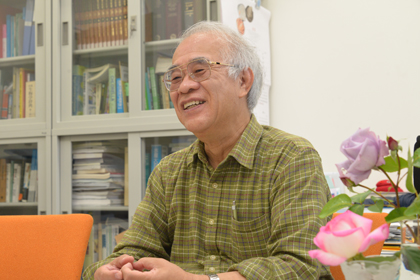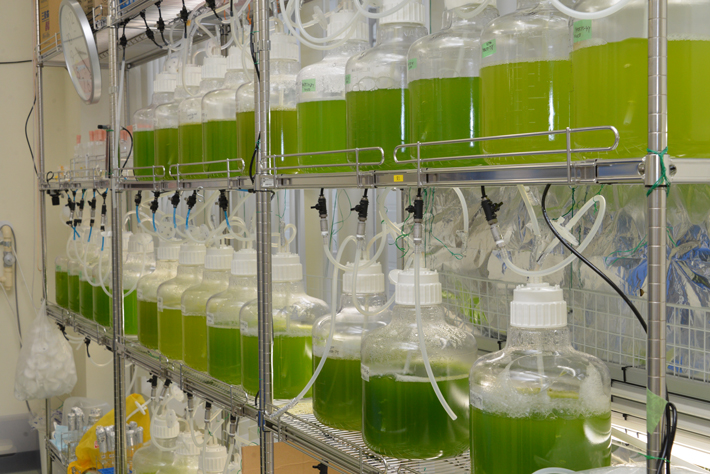TSUKUBA FRONTIER
#06 The Long-Awaited Flowering of Algae Research Holds Promise for Biomass Power
Research to extract fuels and raw materials for chemical products from algal biomass is one advanced research project representative of activities at the University of Tsukuba. In March 2014, a large-scale demonstration facility was completed, and a major first step was taken toward practical use of oil produced from algae. In addition to advancing this research, Prof. Watanabe is also engaged in creating a framework for cooperation between industry and academia, aiming to return the fruits of this project to society.
Professor WATANABE Makoto, Faculty of Life and Environmental Sciences

■ The planet-creating properties of algae

Algae are, like terrestrial plants, organisms that live via photosynthesis. They do not have clearly differentiated roots or stems, and do not produce pretty flowers. But from the cyanobacteria that were the most primitive organisms on the evolutionary path of life through to the varieties of seaweed that we Japanese are so familiar with, algae include organisms that span a vast range.
In classification systems, algae are lower-ranking vegetation, but they have played a vital role in creating the earth in its present form. Approximately three billion years ago, when nearly all of the earth's atmosphere consisted of carbon dioxide, the first algae (cyanobacteria) appeared and began photosynthesis. The oxygen generated in this reaction oxidized metals in the ocean to create iron ores and other ores, and changed the atmosphere into an oxygen-rich composition. The algae that had flourished vigorously up until 100 million years ago sank to the ocean floor, and in a high-temperature, high-pressure environment, were gradually converted into petroleum. It can be said that human civilization was made possible thanks to algae.
There is increasing interest in research on using this latent oil-producing power of algae as a resource. For a while, biofuels produced from terrestrial plants were in the limelight as a possible replacement for petroleum, but because many of these fuels used as raw materials crops that originally served as foods, such as soybeans and corn, these fuels were not widely adopted. However, algae does not pose similar problems for food supply, and can be cultivated anywhere that water, nutrients, and sunlight are present, so that farmland is unnecessary. Moreover, algae boasts tens to hundreds of times the oil-producing capability of terrestrial plants.
■ From fuels to cosmetics

Among the types of algae present on earth, which are said to number in the tens of millions including species not yet discovered, two were selected: Botryococcus and Aurantiochytrium. Both produce the hydrocarbon oils that are the main components of petroleum, are optimal raw materials for production of transport fuels, and can also be used as starting materials for the production of chemical products, cosmetics, and the like.
Basic research on Botryococcus has continued since the 1960s, but its slow growth and low efficiency of oil production was seen as a problem. Attempts to improve the variety through genetic engineering were hindered by the hard membrane of the cells, making conventional techniques for gene introduction unusable. After trying various other methods, a new technique for gene introduction was finally perfected, and dramatic breeding improvements are now anticipated.
Aurantiochytrium does not use photosynthesis, but produces DHA (docosahexaenoic acid). DHA is known as a healthy ingredient that is present in fish, but it is in fact created by the algae that fish feed on, accumulating within the bodies of the fish. At the University of Tsukuba, an alga was discovered that accumulates squalene, which is a higher hydrocarbon, and the alga was successfully cultivated in large quantities. Squalene is thought to have moisturizing and anti-aging effects, and applications in cosmetics, supplements, and the like are now being studied.
■ The wandering path of algal biomass research
Research on algal biomass has been repeatedly interrupted and restarted, driven by the international situation. Research on oil use first began in the U.S. in the 1970s, upon the occasion of the first oil shock, when development of fuels to substitute for petroleum became an urgent mission. This research was continued into the mid-1990s, but as crude oil prices remained stable at low prices in this period, there was no longer a perceived need for research.
As if taking over from the Americans, research was started in Japan because of the increasing attention being paid to global warming. A decade-long large-scale national project was undertaken, with the aim of having algae absorb carbon diode. However, the project ended without ever reaching any prospect of commercialization.
The next wave of research came in 2007. The occasion was a spike in oil prices, but instead of a temporary economic situation, the cause of the research was rapid advances in developing nations, leading to a renewed interest in algae as a permanent solution. At the University of Tsukuba, research on algae had begun several years before this wave. Initially this research received little assistance, but as promising research results were obtained, the national government restarted research support. Thus, work on algae was revived at the University of Tsukuba.
■ A step toward returning benefits to society
The research on algae has practical use as its objective. Production technology that has been developed up until now will be optimized, attempting to achieve production costs that will make such oil competitive in the market. The large-scale demonstration facility is an important R&D center that has no counterpart outside of the University of Tsukuba. We are assembling a research system that will include everything from basic biology-centered research through to expanding the scale of production, and engineering and chemical/medical studies aimed at developing new applications.
Diversification of energy sources and global warming constitute problems common to the entire planet. Algal biomass holds unlimited possibilities, not only for renewable fuels, but for uses in petrochemical products, cosmetics, supplements, and other applications. With a view to industrialization, a consortium has been established with some 80 private-sector companies participating, actively engaged in information exchange and market development. A robust engineering foundation will be established, preparing the way to return these benefits to society. In the future, algae will no doubt undergo its own vigorous flowering.

Article by Science Communicator at the Office of Public Relations


